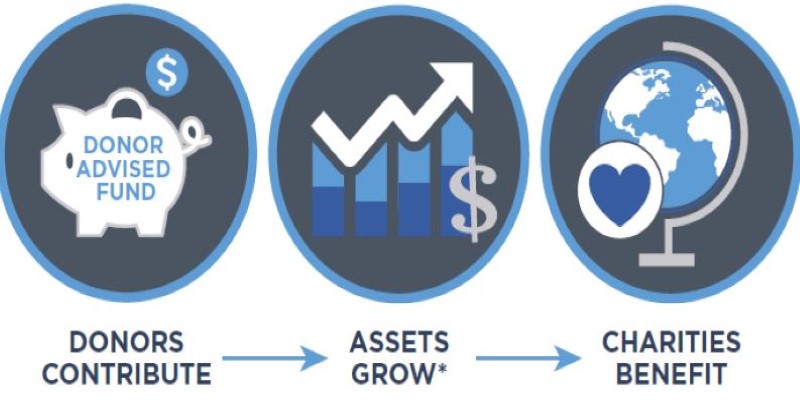Maximizing Your Charitable Giving with Donor-Advised Funds: Advantages and Disadvantages
Dec 11, 2024 By Sid Leonard
Donor-advised funds (DAFs) have gained popularity as a strategic option for individuals looking to make a difference through charitable giving. They allow donors to take a proactive role in managing their charitable contributions, offering both flexibility and control over how funds are distributed. However, like many financial tools, DAFs come with their own set of advantages and limitations that make them suitable for some donors and less ideal for others.

If you're looking at donor-advised funds as a means of streamlining your giving, you'll want to keep in mind the pros and cons of this tool. So, let's dig into the world of donor-advised funds so you'll be really prepared to decide if this giving option fits in with your philanthropic goals.
What Are Donor-Advised Funds?
Donor-advised funds are, in essence, charitable investment accounts maintained within a sponsoring organization, often a community foundation or the charitable arm of a financial services provider. When opening a DAF, you place money or assets of value into the account for an immediate tax deduction. You can recommend how and when these funds will be distributed to charities. Most charitable donations call for the distribution of funds on demand; DAFs offer more flexibility.
The flexibility to plan and delay disbursements makes DAFs appealing to those who want to maximize the impact of their contributions without rushing decisions. While donors cannot directly access the funds once contributed, they can guide the sponsoring organization in allocating the funds to charities over time.
The Benefits of Donor-Advised Funds
One of the main reasons DAFs have become so popular as a charitable vehicle is the peculiar set of benefits. For details, here are some of the main advantages:
Immediate Tax Deductions with Long-Term Giving Options
Contributing to a donor-advised fund allows for an immediate tax deduction, even if the funds are distributed to charities later. This can be especially helpful in high-income years, as it reduces taxable income now while offering time to make thoughtful donation choices. With this flexibility, donors can research organizations and adapt their giving plans over time, aligning contributions with evolving priorities and needs without rushing into decisions.
Efficient Financial Management and Growth Potential

Donor-advised funds allow contributions to grow while awaiting distribution, as funds are often invested, potentially increasing the amount eventually donated. This growth magnifies the impact of the initial donation over time. Additionally, DAFs simplify financial management by consolidating charitable records, reducing the need for separate tracking across various donations. This streamlined approach makes it easier to review and manage charitable giving efficiently.
Family Legacy and Engagement in Philanthropy
Donor-advised funds are ideal for involving family members in charitable giving, fostering a shared purpose, and passing down philanthropic values. Many donors make their DAFs multi-generational, allowing children or grandchildren to recommend grants. This setup cultivates a family legacy, encouraging younger generations to understand social impact, participate actively in charitable efforts, and appreciate the importance of giving back as a lasting family value.
The Drawbacks of Donor-Advised Funds
While donor-advised funds offer notable benefits, they also come with certain drawbacks. Here are some of the challenges and limitations of DAFs:
Lack of Immediate Impact on Charities
One of the primary criticisms of donor-advised funds is that contributions dont always reach charities immediately. Funds can sit in DAF accounts for years, sometimes indefinitely, while donors decide on the timing and recipients of their grants. This lack of immediate disbursement can be problematic in situations where charitable organizations require urgent funding for crises or pressing needs. Unlike direct donations, which immediately empower charities to act, DAFs sometimes delay much-needed funding.
Potential for High Fees and Less Transparency
Donor-advised funds often come with fees for administrative and investment management services, which vary by provider and specific investments. These fees can diminish potential growth, especially in smaller accounts, impacting the total funds available for charities. Additionally, DAFs sometimes lack detailed reporting on fund movements, complicating transparency for external parties. This limited visibility raises concerns for critics who question how effectively DAFs contribute to charitable causes, as their distribution paths arent always clear.
Limited Control and Restrictions

While DAFs offer flexibility, they also have limitations. Donors can recommend grants, but the sponsoring organization has the final say in whether those grants are approved. This setup generally works well with established charities but may restrict support for unconventional causes. Moreover, DAF providers may impose specific restrictions on the types of charities eligible to receive funds. As a result, donors should ensure their intended beneficiaries align with the DAF providers guidelines to avoid grant denials.
Are Donor-Advised Funds Right for You?
The decision to use a donor-advised fund ultimately depends on your charitable objectives, financial situation, and how you want your philanthropy to be managed. DAFs tend to appeal to donors who prefer a structured, strategic approach to their charitable giving. If youre someone who wants to contribute a significant amount to charity but isnt ready to make all the decisions at once, a DAF may provide the flexibility you need. Its also worth considering a DAF if youre interested in growing your donations over time, leveraging tax advantages, or creating a family-centered approach to giving.
However, if your primary goal is to get resources directly into the hands of charities without delay, or if you want complete control over your donations, other giving options like direct contributions or setting up a private foundation may better suit your goals.
Conclusion
Donor-advised funds offer a strategic, flexible way to manage charitable giving, allowing donors to take advantage of tax benefits while planning their contributions thoughtfully. However, these benefits come with potential downsides, including delayed impact, administrative fees, and some restrictions. Whether DAFs suit you depends on your philanthropic goals, values, and the urgency of the causes you support. Evaluating how DAFs fit into your financial and charitable objectives can help ensure your donations make the intended impact, allowing you to leave a meaningful legacy.








